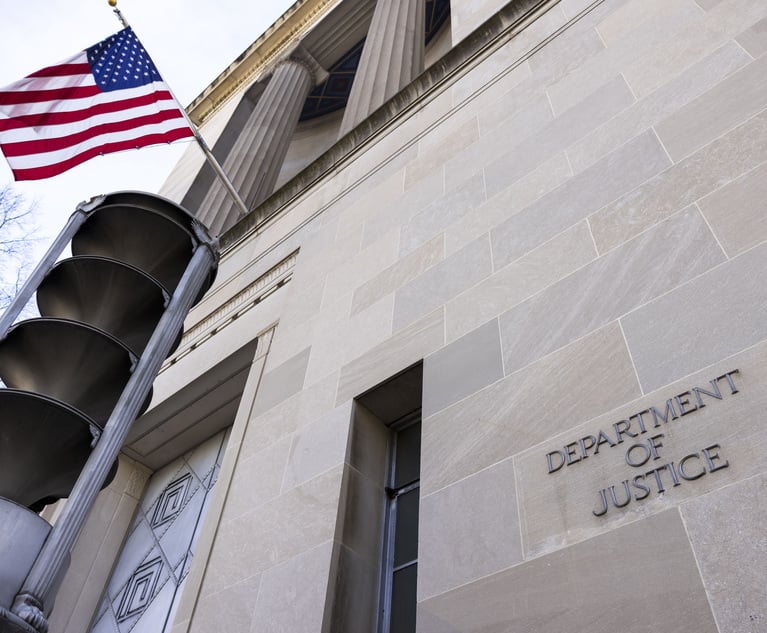Are Database Systems Patentable?
In his Patent and Trademark Law column, Rob Maier discusses the Federal Circuit's recent decision in 'BSG Tech v. Buyseasons', which found a patent directed to database functionality invalid as not patent eligible. In the process, the court helped to further define the fuzzy line between good and bad database patents.
September 25, 2018 at 02:45 PM
8 minute read
 Robert L. Maier
Robert L. Maier
The late 1990s and early 2000s brought the gold rush of software patents in the United States. On the heels of the U.S. Supreme Court's decision in State Street Bank, which confirmed that business methods and related software inventions could be patented in the United States, and in the midst of the dot-com boom, thousands flocked to the U.S. Patent & Trademark Office to file new patent applications on software inventions. Many of those patents were related to the ways in which data could be stored and manipulated in computer systems.
In recent years, the pendulum has, by all accounts, swung back in the other direction, as the federal courts and the Patent Office have tightened the reigns on the patentability of software. Database patents, covering systems and methods for arranging and storing data, in particular, have been a lightning rod. The Federal Circuit has repeatedly weighed in on the patentability of such systems; in some instances, finding them to be non-patent eligible, but in other instances upholding the validity of such patents.
Last month, the Federal Circuit in BSG Tech v. Buyseasons again weighed in on this issue, finding a patent directed to database functionality invalid as not patent eligible. In the process, the court helped to further define the fuzzy line between good and bad database patents.
Prior Decisions on Patentability of Database Systems
The Federal Circuit has previously addressed the question of the patentability of database systems, in each case applying the Supreme Court's two-step test for patent eligibility articulated in Alice Corp. v. CLS Bank Int'l, 134 S.Ct. 2347, 2355 (2014). Specifically, at step one, the court considers “whether the claims at issue are directed to a patent ineligible concept”—i.e., a law of nature, natural phenomena, or an abstract idea. If so, the court then at step two considers whether the elements of the claim “transform the nature of the claim” such that it is patent eligible. Id. Notably, and as it pertains to databases, the Supreme Court has held unpatentable “methods of organizing human activity” as abstract.” In re TLI Commc'ns LLC Patent Litig., 823 F.3d 607, 613 (Fed. Cir. 2016).
The Federal Circuit has repeatedly found database-related patents invalid. As one example, in Intellectual Ventures I v. Capital One Fin., 850 F.3d 1332 (Fed. Cir. 2017), the court found that inventions covering XML data storage systems were, “at their core, directed to the abstract idea of collecting, displaying, and manipulating data,” and that the series of generic computer components used to carry out that idea were “simply not enough under step two.” Id. at 1340. In another such case, ZKey Investments v. Facebook, 708 Fed.Appx. 681 (Fed. Cir. 2018), the Federal Circuit considered a patent directed to a database management system that stores user profile information, and found it claimed only the abstract idea of “collecting, storing, and sharing information of registered users with other registered and non-registered users,” and did not add any inventive concept.
However, in other cases, the Federal Circuit has found databases patent-eligible. For example, in Enfish v. Microsoft, 822 F.3d 1327, 1337 (Fed. Cir. 2016), the Federal Circuit concluded that patent claims related to database structure were not abstract because their focus included a new and particular “self-referential table [that] functions differently than conventional database structures.” The table enabled programs to construct databases in new ways and more efficiently than they could with prior systems, and the Federal Circuit distinguished this as a technological improvement in computer functionality, which differed from other tasks “for which a computer is used in its ordinary capacity.” Id. at 1336. Similarly, in Visual Memory v. NVIDIA, 867 F.3d 1253 (Fed. Cir. 2017), the Federal Circuit determined that the claims there were directed to “an improved memory system,” which configured operational characteristics of a computer's memory based on the kind of processor it was mated to—again, according to the Federal Circuit, an improvement in the way that computer systems store and access data. Id. at 1256-57, 1259.
The Federal Circuit in 'BSG Tech'
The Federal Circuit has now again weighed in on the patentability of a database system patent. BSG Tech sued Buyseasons for infringement of three patents related to systems and methods for indexing information stored in wide access databases. The patents—U.S. Patent Nos. 6,035,294, 6,243,699, and 6,195,652—are directed to a “self-evolving generic index” for organizing information stored in a database. The claimed indexing software organizes information about various items using classifications, parameters, and values. As an example, information about a car could be organized as a series of classifications such as a first “Automobile” classification, a second “Used Vehicle” classification, and a third “Sports Utility Vehicle” classification.
According to BSG Tech, prior database systems provided similar hierarchical-type classification systems, but suffered from several shortcomings in that they were somewhat rigid and did not allow for classification of wide ranges of products and services, and did not allow users to sort records based upon customized parameters. BSG Tech argued that the asserted patents overcame these shortcomings because they allowed users to add new parameters, guided by the patented system, which would help the users to maintain consistency in how they describe items by providing information about parameters that previous users chose in similar classification systems.
Buyseasons moved to dismiss the suit based on its contention that all asserted patent claims were invalid under §101. Judge Schroeder of the Eastern District of Texas converted the motion to dismiss into a motion for summary judgment and granted the motion. The court applied the two-step test for patent eligibility provided by the Supreme Court in Alice v. CLS Bank, concluding that the asserted patent claims “are directed to the abstract idea of considering historical usage information while inputting data,” and furthermore lack any inventive concept sufficient to transform those claims into patent-eligible subject matter. BSG Tech appealed.
In step one of the Alice analysis, the Federal Circuit agreed with the district court “that the asserted claims are directed to the abstract idea of considering historical usage information while inputting data.” The court found that the patented method is not necessarily rooted in computer technology intended to overcome a specific technological problem in wide access databases; rather, according to the Federal Circuit, the invention amounted to either a “fundamental, long-prevalent practice or a well-established method of organizing activity” and, either way, constitutes an abstract idea.
As to step two, the Federal Circuit then considered whether the elements of the claims beyond the abstract idea transform the nature of the claims into a patent-eligible application. The court explained that those transformative elements must supply an “inventive concept” that ensures the patent amounts to “significantly more” than a patent covering merely the abstract concept itself.
The Federal Circuit determined that the only feature BSG Tech alleged to be unconventional is the requirement that users are guided by comparison usage information or relative historical usage information—which, the court found, “simply restated what we have already determined is an abstract idea.” The court therefore concluded that this reformulating of the abstract idea did not add “significantly more,” and thus found the district court did not err in determining that the claims lack an inventive concept.
Furthermore, BSG Tech argued that the claims supply an inventive concept because they require a specific database structure that does not preempt the entire abstract concept of employing historical usage information while inputting data into other types of databases. Here, the court relied on its precedent finding “the absence of complete preemption does not demonstrate patent eligibility,” and concluded that although BSG narrowed its patent claims to specific database structures, “those structures are well-understood and conventional,” and thus cannot support an inventive concept. Ultimately, the Federal Circuit affirmed the finding of invalidity of the patents.
While Enfish and Visual Memory provided examples of database systems that were found patent-eligible, the Federal Circuit here reconfirmed that, as in the past, some database patents will fall on the other side of the line. In particular, in BSG Tech, the Federal Circuit framed the difference as “an improvement to the information stored by a database” (which is not eligible for patenting) versus “an improvement in the database's function.” The precise contours of this line still remain somewhat unclear, but, as the Federal Circuit continues to provide examples on either side, those examples may continue to provide guidance, both for those drafting patent applications, and those enforcing—or defending against—database patents.
Rob Maier is a patent trial lawyer and intellectual property partner in the New York office of Baker Botts.
This content has been archived. It is available through our partners, LexisNexis® and Bloomberg Law.
To view this content, please continue to their sites.
Not a Lexis Subscriber?
Subscribe Now
Not a Bloomberg Law Subscriber?
Subscribe Now
NOT FOR REPRINT
© 2025 ALM Global, LLC, All Rights Reserved. Request academic re-use from www.copyright.com. All other uses, submit a request to [email protected]. For more information visit Asset & Logo Licensing.
You Might Like
View All
'A Shock to the System’: Some Government Attorneys Are Forced Out, While Others Weigh Job Options
7 minute read
'Serious Legal Errors'?: Rival League May Appeal Following Dismissal of Soccer Antitrust Case
6 minute read
How Some Elite Law Firms Are Growing Equity Partner Ranks Faster Than Others
4 minute read
Trending Stories
- 1NY No-Fault Insurance Adopts Worker’s Compensation Fee Schedule
- 2With AI Expected to Be a Focus This Year, What Changes Can Midsize Firms Expect?
- 3Dissenter Blasts 4th Circuit Majority Decision Upholding Meta's Section 230 Defense
- 4NBA Players Association Finds Its New GC in Warriors Front Office
- 5DC Circuit Keeps Docs in Judge Newman's Misconduct Proceedings Sealed
Who Got The Work
J. Brugh Lower of Gibbons has entered an appearance for industrial equipment supplier Devco Corporation in a pending trademark infringement lawsuit. The suit, accusing the defendant of selling knock-off Graco products, was filed Dec. 18 in New Jersey District Court by Rivkin Radler on behalf of Graco Inc. and Graco Minnesota. The case, assigned to U.S. District Judge Zahid N. Quraishi, is 3:24-cv-11294, Graco Inc. et al v. Devco Corporation.
Who Got The Work
Rebecca Maller-Stein and Kent A. Yalowitz of Arnold & Porter Kaye Scholer have entered their appearances for Hanaco Venture Capital and its executives, Lior Prosor and David Frankel, in a pending securities lawsuit. The action, filed on Dec. 24 in New York Southern District Court by Zell, Aron & Co. on behalf of Goldeneye Advisors, accuses the defendants of negligently and fraudulently managing the plaintiff's $1 million investment. The case, assigned to U.S. District Judge Vernon S. Broderick, is 1:24-cv-09918, Goldeneye Advisors, LLC v. Hanaco Venture Capital, Ltd. et al.
Who Got The Work
Attorneys from A&O Shearman has stepped in as defense counsel for Toronto-Dominion Bank and other defendants in a pending securities class action. The suit, filed Dec. 11 in New York Southern District Court by Bleichmar Fonti & Auld, accuses the defendants of concealing the bank's 'pervasive' deficiencies in regards to its compliance with the Bank Secrecy Act and the quality of its anti-money laundering controls. The case, assigned to U.S. District Judge Arun Subramanian, is 1:24-cv-09445, Gonzalez v. The Toronto-Dominion Bank et al.
Who Got The Work
Crown Castle International, a Pennsylvania company providing shared communications infrastructure, has turned to Luke D. Wolf of Gordon Rees Scully Mansukhani to fend off a pending breach-of-contract lawsuit. The court action, filed Nov. 25 in Michigan Eastern District Court by Hooper Hathaway PC on behalf of The Town Residences LLC, accuses Crown Castle of failing to transfer approximately $30,000 in utility payments from T-Mobile in breach of a roof-top lease and assignment agreement. The case, assigned to U.S. District Judge Susan K. Declercq, is 2:24-cv-13131, The Town Residences LLC v. T-Mobile US, Inc. et al.
Who Got The Work
Wilfred P. Coronato and Daniel M. Schwartz of McCarter & English have stepped in as defense counsel to Electrolux Home Products Inc. in a pending product liability lawsuit. The court action, filed Nov. 26 in New York Eastern District Court by Poulos Lopiccolo PC and Nagel Rice LLP on behalf of David Stern, alleges that the defendant's refrigerators’ drawers and shelving repeatedly break and fall apart within months after purchase. The case, assigned to U.S. District Judge Joan M. Azrack, is 2:24-cv-08204, Stern v. Electrolux Home Products, Inc.
Featured Firms
Law Offices of Gary Martin Hays & Associates, P.C.
(470) 294-1674
Law Offices of Mark E. Salomone
(857) 444-6468
Smith & Hassler
(713) 739-1250






